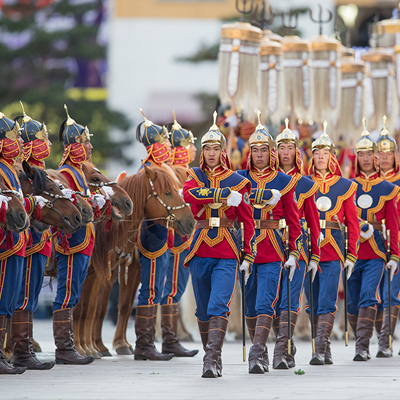
People’s revolution (1921) and Building Socialism
The People’s Revolution of 1921 (or Mongolian Revolution of 1921) was a military and political event which were helped by the Soviet authorities to rebel against the Chinese occupation forces in Mongolia. The Mongolian People’s Party was set up at a meeting of 26 revolutionaries. They adopted what are called the “Ten Aspirations”, promising to resolve matters of external and internal policy in the long-term intersts of nation. Damdiny Suhbaatar was one of the outstanding leaders in the national revolution and the founder of the people’s army of Mongolia.
The Mongolian Bogd Khan, the political religious leader, who had been taken hostage by the Chinese, was released by von Ungern-Sternberg (also known as Mad Baron), who set up a new government. The soldiers of the people’s army came to liberate the Urga from the (present Ulaanbaatar) from the Baron Ungern on the July 6, 1921. The revolutionaries, encouraged by the Soviets, adopted a communist, rather than nationalist, approach and there was a limited monarchy until the Bogd Khan’s death in May 1924.
At the end of 1924, a national assembly, or Great Khural, approved the country’s first constitution and a second chamber of 30 members, the Little Khural, was elected. It then elected a five-man Presidium and chose the government. The Mongolian People’s Republic was proclaimed and the capital renamed Ulaanbaatar. The Great Khural resolved that Soviet Russia was Mongolia’s ‘only friend and ally’ and that, ‘in alliance with the Soviet working class’, the Mongolian People’s Republic would ‘bypass capitalism and enter socialism’.
The Mongolian People’s Revolutionary Party ordered seizure of religious property, expelled the lamas from the monasteries and imprisoned or killed their leaders in purges that all but destroyed Buddhism. Herdsmen, urged to join the government-run collectives, took fright and slaughtered their livestock and, by 1932, terror and food shortages brought the people to the brink of civil war, prevented only by Soviet intervention.
Mongolia’s great Khural met once every three years to draw up basic policy, revise the constitution and elect the Little Khural, where power was concentrated in the hands of a small group of leaders who ran the country for long periods free from the need to explain their actions.
In the lead up to World War II, Mongolia followed Soviet ideology and accepted the ideas of communism. China finally recognized Mongolian independence in 1946. When the People’s Republic of China was created in 1949, Mongolia found herself surrounded by two giant communist states, China and Russia. The Sino-Soviet split at the end of the 1950s temporarily dashed hopes of a good relationship between the three countries.
In 1940 Mongolia had predominantly a nomadic livestock-raising economy, but in the post-war years herding was collectivized, arable farming was expanded and mining and light industry developed considerably. The Trans-Mongolian Railway linking the USSR and PRC was put into operation in 1955.
Mongolia became a member of the United Nations in 1961, a member of the CMEA (Comecon) in 1962, opened diplomatic relations with the United Kingdom in 1963, agreed a new Mutual Assistance Treaty with the USSR in 1966.
Starting from 1980, the socialist system seemed to be collapsed and especially, “reconstruction by M.S.Gorbachev” in the Soviet Union was in full swing. Following the political consequences of development of democracy and open opinions, new political parties emerged in Mongolia.










.jpg)















